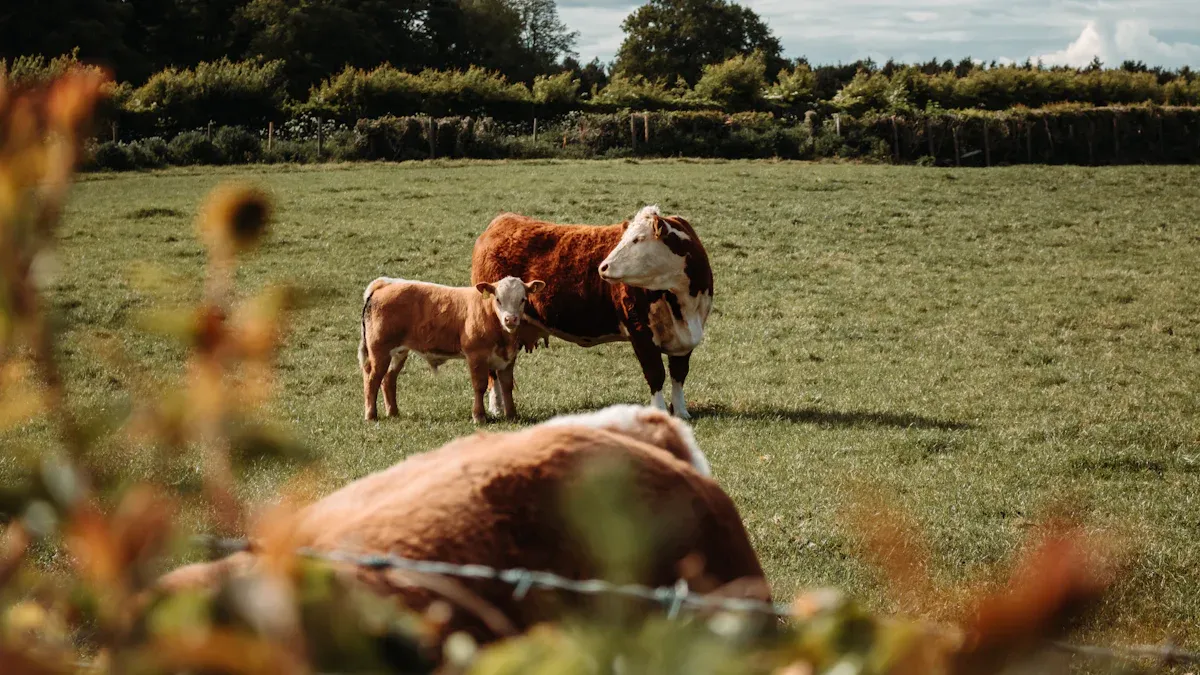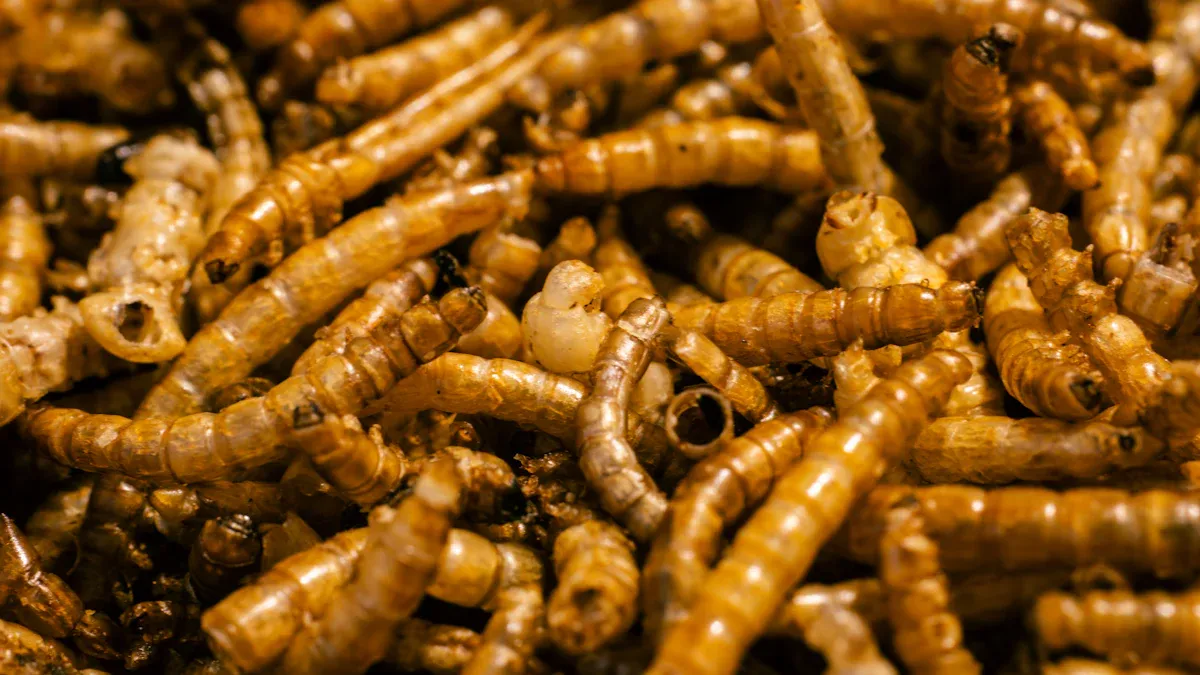
You want your livestock to thrive, right? Mealworms feed for livestock is a game-changer. Packed with 48% protein by weight, they rival soy while using 500 times less water. Plus, they’re a sustainable option for farms in the UK. Their essential amino acids and high energy content make mealworms feed for livestock perfect for boosting productivity.
Key Takeaways
- Mealworms have 48% protein, so they help animals grow strong.
- Pick sellers who care about the planet and get mealworms responsibly.
- Store mealworms well; keep them cool, dry, and in sealed containers.
Nutritional Benefits of Mealworms Feed for Livestock

High Protein Content for Optimal Growth
Protein is the building block for growth, and mealworms deliver it in abundance. With a protein content of 48%, dried mealworms rival traditional feed sources like soy, which contains 50%. This makes them an excellent choice for supporting the rapid growth and development of your livestock. Whether you’re raising poultry, pigs, or fish, mealworms provide the high-quality protein needed to build muscle and improve overall health.
Mealworms also convert feed into body weight efficiently. For every two pounds of food they consume, they produce one pound of mealworms. This efficiency means you get more protein-rich feed with less input, saving resources while ensuring your animals thrive.
Rich Source of Essential Nutrients and Amino Acids
Mealworms are more than just a protein powerhouse. They’re packed with essential amino acids, fats, vitamins, and minerals that your livestock needs to stay healthy. Studies show that mealworms reared on fermented chicory roots have even higher mineral content, making them a nutrient-dense option for your farm.
Their nutritional profile closely matches that of fishmeal and soybean meal, but with added environmental benefits. This makes mealworms feed for livestock a sustainable and nutritious alternative that doesn’t compromise on quality.
A Versatile Feed for Different Livestock Types
One of the best things about mealworms is their versatility. They’re suitable for a wide range of animals, including poultry, pigs, fish, and even exotic pets like lizards and geckos. Many animals prefer mealworms over traditional feed, thanks to their natural taste and texture.
Mealworms can replace conventional proteins in livestock diets without sacrificing performance. They’re especially beneficial for omnivorous animals, offering a balanced mix of nutrients that supports growth, reproduction, and overall well-being. Whether you’re running a poultry farm or raising trout, mealworms feed for livestock is a reliable and adaptable choice.
Choosing a Reliable Supplier for Mealworms Feed
Importance of Sourcing and Sustainability
When choosing a supplier, you need to think about where and how the mealworms are sourced. Ethical sourcing ensures that the production process is environmentally friendly and sustainable. Did you know that mealworms have a water footprint of just 4341 m³ per ton? That’s comparable to chicken meat and 3.5 times lower than beef. By choosing mealworms, you’re not just feeding your livestock—you’re helping the planet.
Mealworms can also replace fishmeal and soybean meal, which are linked to overfishing and deforestation. This switch reduces emissions and protects natural habitats. Plus, sustainable sourcing can lead to financial benefits for both feed producers and farmers like you.
Verifying Certifications and Compliance with UK Standards
You want to make sure your supplier meets all UK regulations. Look for certifications that prove their mealworms feed complies with safety and quality standards. These certifications ensure the feed is free from harmful contaminants and safe for your livestock.
UK standards also emphasize sustainability. A certified supplier is more likely to follow ethical practices, giving you peace of mind. Always ask for documentation to verify compliance. It’s a simple step that can save you from potential risks.
Transparency in Quality and Processing Practices
Transparency is key when selecting a supplier. You should know exactly how the mealworms are processed. For example, the microbial load in mealworms can affect their safety and shelf life. Some studies show that pulverized mealworms may contain high levels of bacteria, which could pose risks if not properly managed.
A reliable supplier will openly share details about their processing methods. They’ll also provide information about testing and quality control. This transparency helps you trust that the mealworms feed for livestock you’re buying is safe and nutritious.
Ensuring Quality and Safety in Mealworms Feed
Testing for Contaminants and Adhering to Safety Standards
You want to ensure your livestock gets safe and nutritious feed, right? That’s why testing for contaminants is crucial when it comes to mealworms feed. Reliable suppliers follow strict protocols to check for harmful substances like heavy metals and mycotoxins. For example, studies show that mealworms (T. molitor) raised on mineral-rich biowaste don’t accumulate harmful levels of lead, cadmium, or arsenic.
Here’s a quick look at some findings:
| Contaminant | Result |
|---|---|
| Cadmium | Uptake reported in T. molitor and Hermetia illucens. |
| Lead | Uptake reported in T. molitor and Hermetia illucens. |
| Arsenic | Uptake reported in T. molitor and Hermetia illucens. |
Testing also ensures that mealworms feed meets UK safety standards. This includes analyzing microbial loads and ensuring no harmful accumulation of toxins. By choosing a supplier that prioritizes safety, you can confidently provide your livestock with high-quality feed.
Maintaining Consistent Nutritional Value
Consistency matters when feeding your animals. Mealworms feed for livestock offers a stable nutritional profile, but only if the production process is carefully managed. Suppliers often test for macro- and micromineral content to ensure the feed meets your livestock’s dietary needs.
For example, studies have shown that mealworms bred on mineral-rich biowaste maintain their nutritional value without harmful side effects. This means you can rely on mealworms to deliver the same high-quality protein, amino acids, and essential nutrients every time.
Traceability in the Feed Supply Chain
Traceability is another key factor in ensuring quality. You should know where your mealworms come from and how they’re processed. A transparent supply chain helps you track every step, from sourcing to delivery.
Some suppliers even provide detailed records of their production methods. This includes information about the substrates used to raise mealworms and the safety measures in place. With traceability, you can trust that the feed you’re using is both safe and sustainable.
Proper Storage and Usage of Dried Mealworms
Best Practices for Storing Mealworms Feed
Proper storage is essential to maintain the quality of dried mealworms. For short-term storage, refrigeration works well. It keeps blanched mealworms fresh for up to 10–12 days without significant spoilage. If you need a longer shelf life, lactic acid fermentation is a great option. This method stabilizes microbial populations, allowing mealworm pastes to stay safe for up to eight weeks at 4°C.
Here are some quick tips for storage:
- Keep mealworms in a cool, dry place to prevent mold.
- Use airtight containers to avoid contamination.
- Refrigerate or ferment mealworms for extended freshness.
By following these practices, you can ensure your feed remains safe and nutritious for your livestock.
Incorporating Mealworms into Livestock Diets
Mealworms are a fantastic addition to livestock diets. They’re rich in protein, amino acids, and essential nutrients, making them a great alternative to traditional feeds like soybean meal. Research shows that mealworms can replace soy in diets for poultry, pigs, and fish without compromising growth or health.
Here’s a quick comparison:
| Nutritional Aspect | Mealworms | Soybean Meal |
|---|---|---|
| Protein Content | 48% | 50% |
| Total Energy per Pound | Higher | Lower |
| Crude Fiber Content | Lower | Higher |
Mealworms are also easier to process and require fewer resources, making them a sustainable choice for your farm.
Avoiding Common Mistakes in Feed Management
Managing mealworms feed properly ensures your livestock gets the best nutrition. Avoid these common mistakes:
- Improper Ventilation: High CO2 levels can harm mealworms. Ensure proper airflow to prevent suffocation.
- Incorrect Humidity: Keep humidity between 50%–70%. This prevents mold and keeps the feed fresh.
- Temperature Issues: Maintain a range of 25°C–31°C. This ensures optimal growth and prevents spoilage.
By monitoring these factors, you can avoid feed waste and keep your livestock healthy.
Mealworms offer a sustainable and nutrient-rich feed option for your livestock. They’re packed with essential amino acids, fats, and minerals, making them a reliable alternative to traditional feeds like soybeans. Plus, their local rearing potential reduces reliance on imported feed, saving resources and cutting costs.
To get the most out of mealworms, choose a supplier that prioritizes quality and sustainability. Proper storage practices, like keeping them in a cool, dry place, ensure your feed stays fresh and safe. By focusing on quality and safety, you’ll provide your livestock with the best nutrition while supporting a greener future.
FAQ
What makes mealworms a sustainable feed option?
Mealworms require less water, land, and energy compared to traditional feeds like soy or fishmeal. 🌱 They’re eco-friendly and help reduce your farm’s environmental footprint.
Can I feed mealworms to all types of livestock?
Yes! Mealworms work for poultry, pigs, fish, and even exotic pets. 🐓🐖🐟 Their versatility makes them a great addition to any farm.
How do I store dried mealworms properly?
Store them in a cool, dry place using airtight containers. For longer storage, refrigerate or ferment them to maintain freshness and quality. 🧊


